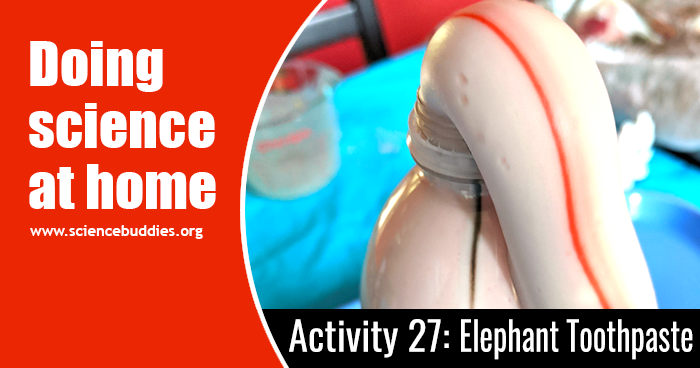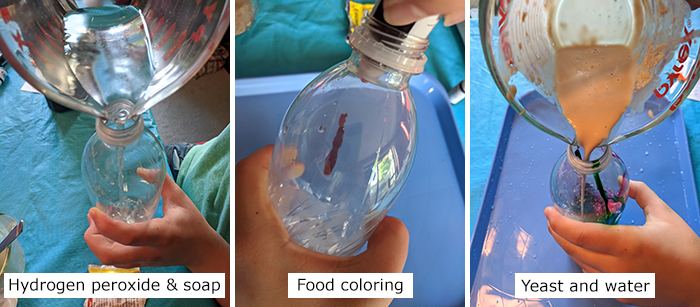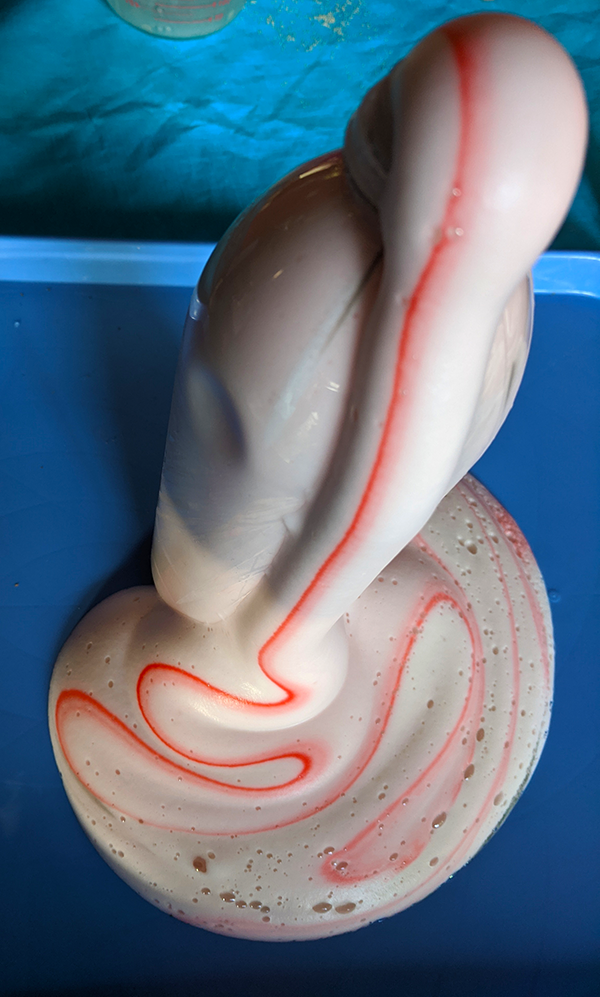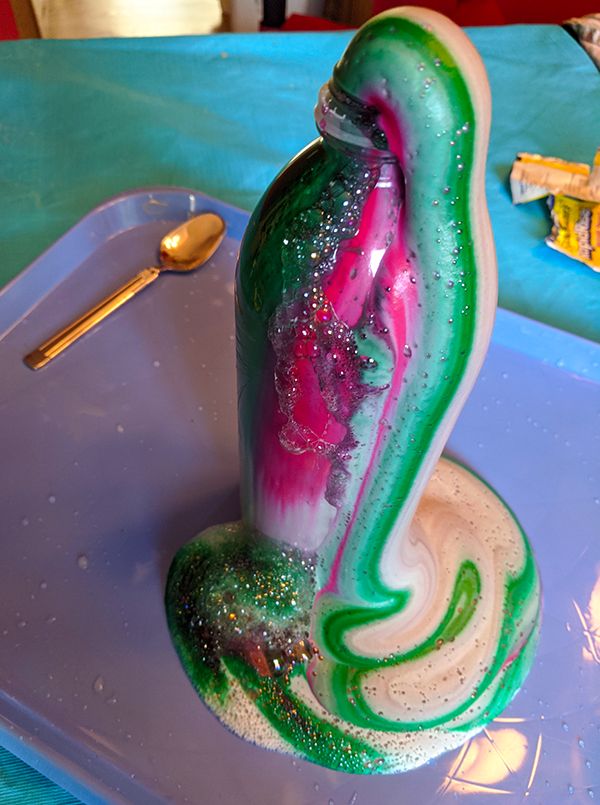Elephant Toothpaste: Doing Fun Science at Home during School Closures (Activity #27)
Follow along with a Science Buddies parent who is using family STEM activities to keep her kids learning at home during the COVID-19 school shutdown. New posts every Monday, Wednesday, and Friday. Today's adventure... foaming fun with elephant toothpaste.

Magic, Otherwise Known as Chemistry
Why are Harry Potter and unicorns so popular? I think it is because kids love magic. They delight in the possibilities and transformations that magic can bring. Chemical reactions, particularly ones that change color, fizz, bubble, foam, or otherwise transform something ordinary into something extraordinary, can delight kids in the same way.
Thinking about the STEM activities we've done so far during the pandemic, I was surprised that we've only done two chemistry reactions — the classic baking soda and vinegar reaction to power our egg rockets and making slime. There are dozens of fun chemistry activities you could do to delight and amaze your children, but here are five of my favorites:
- Make an Alka-Seltzer Powered Lava Lamp: dissolving an Alka-Seltzer tablet in a glass of colored water and vegetable oil gives that 70's era lava lamp vibe.
- Make a Fire Snake: entertaining a tween or teen is easy with this reaction that results in a growing chain of charcoal rising up from the ground.
- Elephant Toothpaste: this fountain of foam can be engineered to look like a gigantic mint-striped squeeze of toothpaste.
- Make a Lemon Volcano: some simple kitchen materials are all it takes to get this volcano bubbling away — you can also experiment with other citrus fruits.
- Color-changing Cabbage Chemistry: experiment to see what colors this red cabbage juice can turn when introduced to different kitchen acids and bases.
You can catch a glimpse of most of these reactions in this video showcasing foaming, fizzing, and bubbling science activities:
Note: The Diet Coke and Mentos experiment in the video is not a chemical reaction — it is a physical reaction. It is still cool and eye-catching — just be prepared for a sticky mess.
My Pick of the Day: Elephant Toothpaste
While not part of our COVID-19 science adventure, I have done both the lemon volcano and lava lamp activities with my kids previously. Both activities are quite fun, but I was looking for something novel to keep them really engaged. I ended up choosing the Elephant Toothpaste activity. Not only was it new to my kids, but it tied into a recent minor accident moment in our house. A few days ago, my husband nicked his finger while building a rack in our garage. My second-grade daughter loves to be the medic in cases like this, and she used hydrogen peroxide on his cut. She noticed that the cut bubbled when it came into contact with the hydrogen peroxide. Since the cut and elephant toothpaste have the same reaction (catalase from living cells speeding up a reaction where hydrogen peroxide is broken down into water and oxygen), I thought it was a nice tie-in.
As usual, we started by watching the video:
After quickly gathering the materials and setting up our messy-zone (a plastic tablecloth with a tray on top for easy cleanup), we were ready to start.
I wanted both kids to have a chance to do the experiment, but we decided to do one reaction at a time as it meant fewer chances of something spilling and creating a big mess. Fortunately, the actual setup is quick, so no one was bored or antsy waiting for their turn.
After pouring in the hydrogen peroxide and adding the dish detergent, we put the food coloring in the bottles. Both kids wanted to try stripes of color. My daughter opted for black and red stripes, while my son tried a watermelon theme with pink, green, and black.

I was too lazy to measure the yeast, so for each reaction, we simply put in one 0.25 oz package mixed with three tablespoons of warm water. As soon as the water-yeast mixture hit the hydrogen peroxide, the foaming started. Watching the video was fun, but all three of us agreed that it was definitely cooler to see the foaming reaction in person.
My daughter's red stripe came out very clearly, but the black one couldn't be seen as it ended up being right at the spot the foam tumbled out of the bottle. Always the one to embrace being messy, my daughter was thrilled to stick her hands in the foamy mess and play with it once the initial reaction was over.

My son's watermelon colors ended up being too close together to form precise stripes, but the colors did swirl out together in a visually pleasing chaos. He was happy with the results even if it wasn't what he'd intended.

From start to finish, including talking about the science, the activity took about twenty minutes. If we'd had more yeast, both kids would have gladly kept on trying different color combinations.
If your kids love foaming, fizzing, and bubbling science, be sure and bookmark or pin the 5 Fizzing, Foaming, and Bubbling Science Projects! page for later.
If you make elephant toothpaste or explore any of the other fun chemistry reactions with your kids, we'd love to see. Post a picture of what they make on social media and tag us. You can find us on Twitter, Facebook, and Instagram.
If this blog post was useful to you, please share it with other parents. Follow the links below to see what other science adventures we've been having at home.
View All Posts in this Series
- Activity 1 - Getting Started and Hand Washing
- Activity 2 - Taking Flight with Kites
- Activity 3 - Candle Seesaw and Fire Science
- Activity 4 - Dissecting Flowers
- Activity 5 - Building a Toy Parachute
- Activity 6 - Paper Marbling
- Activity 7 - Shaping Hard-boiled Eggs
- Activity 8 - Invisible Ink
- Activity 9 - Robot Hand
- Activity 10 - Plastic Egg Rockets
- Activity 11 - Rubber Band Guitar
- Activity 12 - Making Model Viruses
- Activity 13 - Air Cannons
- Activity 14 - Balancing an Art Mobile
- Activity 15 - Gumdrop Geometry
- Activity 16 - Solar Updraft Tower
- Activity 17 - Cotton Ball Launcher
- Activity 18 - Wire Water Striders
- Activity 19 - Ice Cream in a Bag
- Activity 20 - Wind-powered Sail Cars
- Activity 21 - Curling Metal
- Activity 22 - Popsicle Stick Catapult
- Activity 23 - Candy Diffusion
- Activity 24 - STEM Videos
- Activity 25 - Making Slime
- Activity 26 - Straw Siphon
- Activity 27 - Elephant Toothpaste
- Activity 28 - Balloon Hovercraft
- Activity 29 - Aluminum Foil Boats
- Activity 30 - Wall Marble Run
A science activity log is available as a Word document or as a Google doc for online convenience. (Just choose "File/Make a copy" to save it to your Google Drive.)
About the Author
Sandra, Science Buddies' Vice President of STEM education, holds a PhD in Genetics from Stanford University and has spent the last twelve years working on science education and STEM outreach. Right now, she's stuck working from her home in the Pacific Northwest with her husband, second grader, middle schooler, and two oddly noisy gerbils. She hypothesizes her sanity will hold as long as she gets a daily dose of sunshine.
Categories:
You Might Also Enjoy These Related Posts:
- Wall Marble Run: Doing Fun Science at Home during School Closures (Activity #30)
- Aluminum Foil Boats: Doing Fun Science at Home during School Closures (Activity #29)
- Hovercraft: Doing Fun Science at Home during School Closures (Activity #28)
- Elephant Toothpaste: Doing Fun Science at Home during School Closures (Activity #27)
- Straw Siphon: Doing Fun Science at Home during School Closures (Activity #26)
- Slime Three Ways: Doing Fun Science at Home during School Closures (Activity #25)
- A STEM Videos Breather: Doing Fun Science at Home during School Closures (Activity #24)
- Candy Experiments: Doing Fun Science at Home during School Closures (Activity #23)











